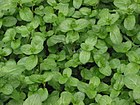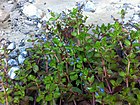Note: This is a project under development. The articles on this wiki are just being initiated and broadly incomplete. You can Help creating new pages.
Veronica beccabunga - Brooklime
Brooklime (Veronica beccabunga), also called European speedwell, is a succulent herb belonging to the family Plantaginaceae. It grows on the margins of brooks and ditches in Europe, North Africa and north and western Asia. It can be found on other continents as an introduced species. It has smooth spreading branches, blunt oblong leaves and small bright blue or pink flowers.The species name beccabunga comes from Danish bekkebunge (literally "brook bunch") or a similar source.
Uses
Parts Used
Chemical Composition
Fresh juice and extract from the herb to contain a bitter principle soluble in water and alcohol, but scarcely in ether; precipitable by salts of lead, but not by tannin; an acrid principle and a red coloring matter, all contained in the precipitate with neutral acetate of lead, together with malic, tartaric, and citric acids[1]
Common names
| Language | Common name |
|---|---|
| Kannada | |
| Hindi | |
| Malayalam | |
| Tamil | |
| Telugu | |
| Marathi | NA |
| Gujarathi | NA |
| Punjabi | NA |
| Kashmiri | NA |
| Sanskrit | |
| English | Agrimony |
Properties
Reference: Dravya - Substance, Rasa - Taste, Guna - Qualities, Veerya - Potency, Vipaka - Post-digesion effect, Karma - Pharmacological activity, Prabhava - Therepeutics.
Dravya
Rasa
Guna
Veerya
Vipaka
Karma
Prabhava
Habit
Identification
Leaf
| Kind | Shape | Feature |
|---|---|---|
| Opposite | short-stalked | Blade elongated sphere–ovate, round-tipped, fleshy, with entire margin or finely serrated |
.[2]
Flower
| Type | Size | Color and composition | Stamen | More information |
|---|---|---|---|---|
| Unisexual | 5–7 mm (0.2–0.28 in.) wide | blue and dark-striped | Stamens 2 | Calyx 4-lobed, lobes glabrous. . Gynoecium fused, single-styled. Inflorescence a short, lax axillary raceme. Flower-stalk shorter than subtending bract |
Fruit
| Type | Size | Mass | Appearance | Seeds | More information |
|---|---|---|---|---|---|
| Almost spherical | 2.5–4 mm (0.1–0.16 in.) long | shallowly notched tip, 2.5–4 mm (0.1–0.16 in.) long, glabrous, brown capsule | With hooked hairs | {{{6}}} |
Other features
List of Ayurvedic medicine in which the herb is used
- Vishatinduka Taila as root juice extract
Where to get the saplings
Mode of Propagation
How to plant/cultivate
Easily grown in a moderately fertile wet soil, growing best in water up to 15cm deep[3]
Commonly seen growing in areas
Photo Gallery
References
External Links
- Pages that are stubs
- Ayurvedic Herbs known to be helpful to treat scurvy
- Ayurvedic Herbs known to be helpful to treat impurity of the blood
- Ayurvedic Herbs known to be helpful to treat burns
- Ayurvedic Herbs known to be helpful to treat ulcers
- Ayurvedic Herbs known to be helpful to treat whitlows
- Ayurvedic Herbs known to be helpful to treat Blotches
- Ayurvedic Herbs known to be helpful to treat Pimples
- Ayurvedic Herbs known to be helpful to treat Diarrhea
- Ayurvedic Herbs known to be helpful to treat Sore throats
- Herbs with Leaves used in medicine
- Herbs with common name in English
- Habit - Perennial herb
- Index of Plants which can be propagated by Seeds
- Herbs that are commonly seen in the region of north as the Shetland
- Herbs that are commonly seen in the region of Highlands ascending up to 2,800 feet
- Herbs that are commonly seen in the region of Ireland and the Channel Islands
- Herbs









